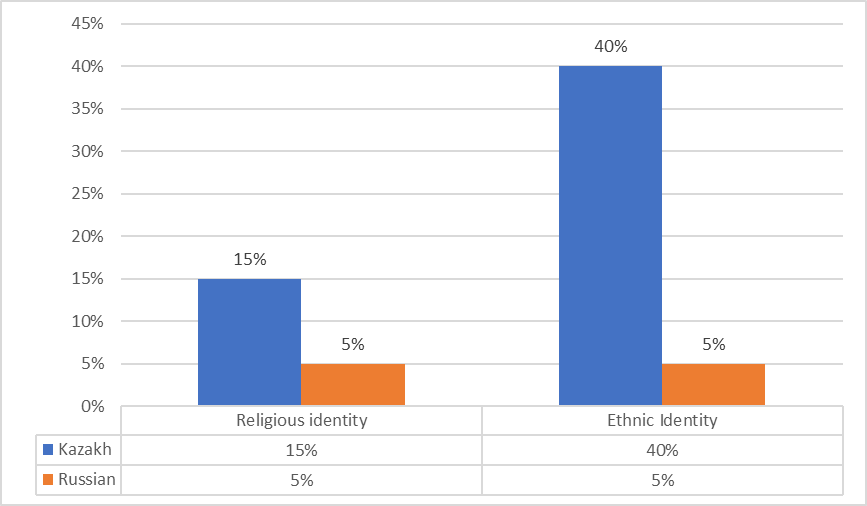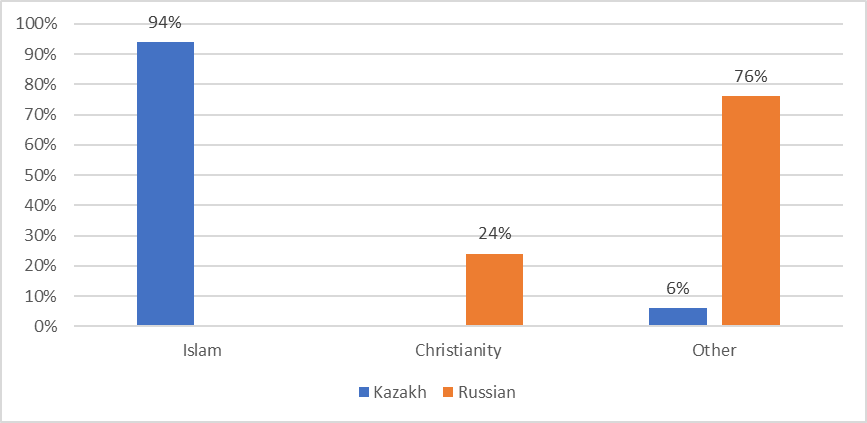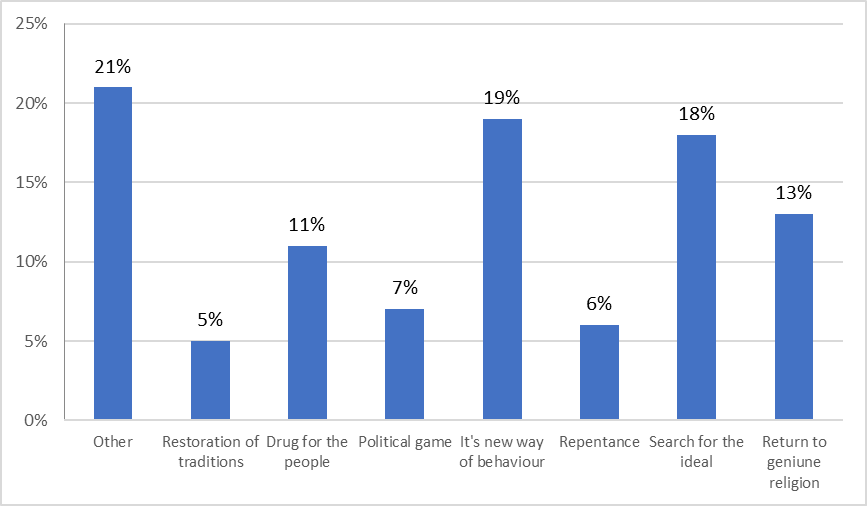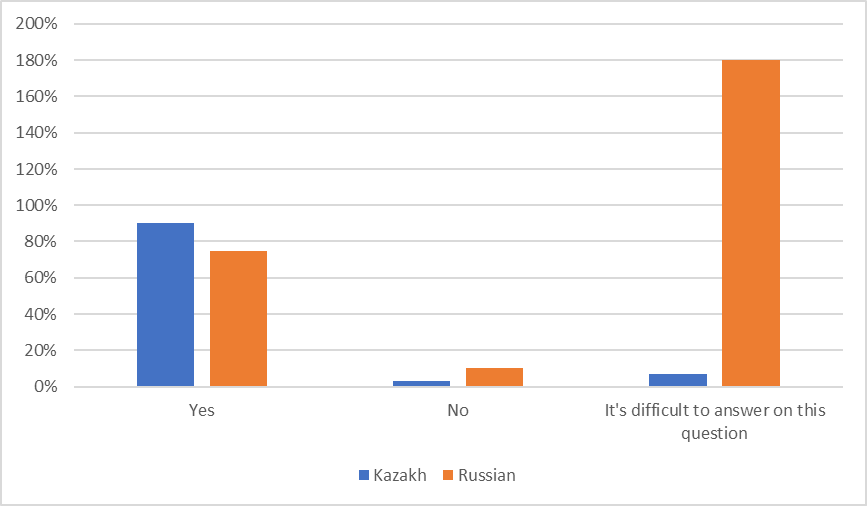Abstract
This article presents the results of the socio-psychological research of religious orientations and preferences of students in Kazakhstan, one of the major states of Central Asia.Kazakhstan, where more 130 ethnic groups live all together, states religious tolerance and acceptance as one of the main internal policies. However, due to the rise of religious extremism and terrorism around the world there is a danger that religious tensions can also affect Kazakhstan. The purpose of this socio-psychological research is to study religious orientation and preference of students in a multicultural and multi-religious society. Research methods include M.Kuhn’s (1954) twenty statements test and Bogdanov’s (2002) questionnaire of religious orientations. Intensity of religious identity is evident among 15% of representatives of Kazakh ethnic and among 5% of representatives of Russian ethnic group. In terms of ethnic identity, it is evident among 40% of ethnic Kazakhs and only among 5% of Russians. 90% of students and 75% of Kazakh-Russian students consider themselves as believers. Thus, our socio-psychological research has shown that religious identity does not take an important place in the self-categorization of the personality of students of both national groups - Kazakh and Russian. In these circumstances, students apart from the religious factor, focus on themselves, define and update their interests in personal, professional, ethnic problems.
Keywords: Religious identityreligious orientation;students
Introduction
The Republic of Kazakhstan gained its independence as the result of collapse of the USSR in 1991. Having the specific geopolitical placement in the heart of Central Asia, Kazakhstan accumulates the diversity of cultures, religious and ethnicities. Despite the fact that population of country is predominantly Muslims, the Constitution states that Kazakhstan is secular country. In this sense, Proclaimed policy let Kazakhstan to remain the island of peace and harmony, where people of different ethnical and cultural backgrounds can live in the atmosphere of tolerance and acceptance.
Nowadays, there are more than 130 ethnic groups, which live in Kazakhstan and share not only territory but also some cultural and religious peculiarities. The majority of population of Kazakhstan are Kazakhs and Russian, whose traditional religions - Sunni Islam and Russian Orthodox Christianity. Also, there is a plethora of different religions: Catholicism, Protestantism, Buddhism, Judaism, Hinduism, ancient and modern polytheistic cults and many other religious and spiritual groups. At present, the country has more than 2,500 religious associations representing some 50 denominations and religious movements.
Despite this religious diversity, Islam is the most common religion among the main part of the Kazakhs, Turks, Chechens, Tatars, Uzbeks and some of the Russian population.
Speaking as an integrating cultural force, Islam promotes the formation of a certain worldview, organically merged with ethnic and religious and ethnic peculiarities of Kazakhstan.
At the same time, Islam in Kazakhstan has several features that allow you to talk about the so-called Kazakh version of Islam.
Chokan Valikhanov (1985) was a first Kazakh scholar, who has studied the ethnogenesis of the people, came to the conclusion that his ethnic history cannot be studied in isolation from religion and beliefs. In this regard, he paid great attention to the study of shamanism, which is considered a kind of primitive religion inherent Kazakhs.
In «Traces of shamanism in Kirghiz» Valikhanov (1985) wrote that despite the fact that Islam has long been accepted by Kazakhs, however, traces of shamanism remain and closely intertwined with the life and customs of the Kazakhs.
Valikhanov (1985) considers Tengriismas an alternative to Islam among the Kazakhs. Religion of Kazakhs is different, on the one hand - this is the worship of the spirits of their ancestors, and on the other - the belief in Allah. To characterize these features of the religion of Kazakhs Valikhanov (1985) coined the term «dualism», which is describes the dualistic attitude to religion among Kazakhs.
Thus, the rooting of Islam in Kazakhstan took place in close connection with the pre-Islamic beliefs and Zoroastrianism, Tengrianism. As a consequence, the Kazakh Islam characterized by tolerance for dissent, recognition of freedom in religion, lack of rigor in compliance with fanatical ritual and legal norms of Sharia.
There is a prejudice that Islam is practiced only by Kazakhs or other representatives of the Turkish people, and Christianity by Russian and Slavic people, however, nowadays people in Kazakhstan tend to choose certain religion based not only on historical background but mostly on personal preferences. In its historical development of Kazakhstan has never been closed, cut off from the world of the island, on the contrary, its vast variety of mixed beliefs and traditions. The population of Kazakhstan celebrates both Muslim and Christian holidays (Qurban Eid and Christmas), as well as many other cultural and religious celebrations.
In this regard, many researchers have noted that it is unlikely in this country may acquire Islam fundamentalist traits.
Problem Statement
In recent years with the development of extremism, the emergence of the Central Asian region, numerous radical Islamic movements among young people, such as «Hizbut-Tahrir», «Eastern Turkistan Islamic Party», «Islamic Jihad», «Jamagat Mujahideen Central Asia», «Jundal-Khilafah», «Tablighijamagat» and othermovements seem to be the real danger. Manifestations of Wahhabisect which have mostly terrorism related nature and as the consequence religious intolerance has acquired special relevance in Kazakhstan. This issue has taken on special significance in the emergence and intensification of activities in the country of such radical movements as Salafis, Wahhabis, and Nurdzhular.In addition, one of the most radical Islamic organization in the world “ISIS” tries to expand its influence on Kazakhstan and recruit Kazakhstani citizens for “holy war” (Aimaganbetova, 2016). Considering young people as the most vulnerable group which can easily be affected by the influence of such organizations due to their state of self-determination and social uncertainty, it is important to study religious orientations and preferences among young population in Kazakhstan.
Research Question
Active dissemination of extremist ideas among young people is determined primarily by factors of socio-economic nature, as part of the youth today can not realize its full resource potential, hence the confusion, apathy, pessimism. Unfortunately, the lack of development of national identity, legal, political nihilism and lack of religious literacy facilitates the mobilization of large numbers of young people under religious slogans.
It is also necessary to take into account the fact that the modern Kazakh young people are more interested in religion than the older generations, brought up under the domination of Soviet atheism. As a result, today, extremism has romanticized among Kazakh youth, especially students (Pavlenko, 2002).
According to Ugrenovich (2012) modern contingent of Kazakh students is a generation whose socialization takes place in an atmosphere of mixed cultures, religious beliefs and value shifts. In higher education institutions students acquainted with representatives of various religious groups and can fall under the specific influence. Under the influence of these contacts, many students adopt fixed patterns of behaviour that they will carry through the entire adult life. Since the period of the end of high school youth completed the process of social stereotyping.
Therefore, the period of youth is extremely important in the context of attitude development and religious orientations.
The determining factor when selecting an object of research for us was the fact that, because of their psychological characteristics, heightened perception of social injustice, the presence of the protest potential students can easily become a tool in the hands of experienced politicians and national and religious radicals, and get into an open confrontation.
Thus, based on the relevance of the topic and given its importance for Kazakhstan, we conducted an empirical study of religious orientations and preferences of Kazakh students.
Purpose of the Study
The purpose of this socio-psychological research is to study religious orientations and preferences of students in multicultural and multi-religious society.
The goal of the hypothesis and identified the main objectives of the study:
• construct and test methodological tools for the measurement of religious attitudes and preferences;
• identify the features of their display of students enrolled at the al-Farabi Kazakh National University.
Research Methods
The study involved 120 participants - students of social science majors of the al-Farabi Kazakh National University. The age of participants from 18 to 26 years (Me=19). The ethnic composition of the sample was 60 students - representatives of the Kazakh ethnic group, and 60students representatives of Russian ethnic group.
Research methods included M. Kuhn’s twenty statements test and A. Bogdanov’s questionnaire of religious orientations (Ugrenovich, 2012).
Findings
The data analysis shows that religious identity is valid for only 10 of the 120 students, and only 10 students, answered the question «Who am I? » based on religious affiliation («Muslim», «Believer», etc.).
In the forms of identity were also observed cross-cultural characteristics. Intensity of religious identity among students of Kazakh nationality was 15%, students of Russian nationality - 5%, while gender identity is represented in 100% of the Kazakh and 99% Russian, 40% of ethnic Kazakhs and only 5% in Russian. 90% of students and 75% of Kazakh-Russian students consider themselves as believers (Figure

The religious identity does not occupy an important place in the self-categorization of personality of students in both samples.
One of explanation of this situation was an age of participants (Me=19), students tend to understand their own personality in interaction with social surrounding.
The results of Bogdanov's «Questionnaire of religious orientations» divided participants on two big groups “believers” and “atheists”.
Results of questionnaire gave us the chance to allocate the following indicators:
• observance of religious instructions;
• type of the pray;
• typical situations of pray;
• reading religious literature
The analysis of results of questioning was also carried out cross-cultural aspect (Figure

As shown in Figure
76% of Russian answer that they are Christians; 24% note that they are atheists, agnostics. We often met this type of answer "I believe in God, but I don't belong to any religion", "I trust in the Universe".
The analysis of answers to the question: "Do you think that there are more believers today? How do you estimate this phenomenon?" is presented in Figure

The majority of students (21%) note that growth of number of believers is manifestation of fashion; 19% chose the answer - "now it is so accepted". For 18% of students’ growth of number of believers is caused by search of an ideal faith; 13% of students estimated growth of believers as a return to true belief. For 11% of examinees the religion still remain "drug for the people", for 7% is "game of politics", for 6% - "repentances" and for 5% - "restoration of traditions".
The analysis of results of students’ answers on a question "Do you consider yourself as the believing person?" provided on figure

90% of Kazakh students and 75% of Russian students consider themselves as believers, and only 3% of Kazakhs and 10% of Russians participants are not believers.
The students’ answer on a question "Do you follow all religious rituals and ceremonies?" shows interesting results. Systematization and the analysis of the obtained data shows that 40% of the students seldom observe the ceremonies and rituals ordered by religion; 25% of students only "sometimes", and 20% of students “never” take part in rituals and ceremonies. The comparative analysis show that from 76% of the students considering themselves as believers, only 40% seldom observe religious practices and rituals.
The following analysis of students’ answer on the question «Do you celebrate religious holidays?» show that 54% of the students celebrate religious holidays in the family,38% mention that they celebrate the most common religious holiday sand only 8% celebrate most prescribed religious holidays.
The analysis and systematization of the students' answers to the question «How often do you visit places of religious worship (church, mosque, synagogue, church, Buddhist temple, etc.)?» show that only 5%of respondents frequently visit places of religious worship, 60% of participants sometimes visit such places and 20% of them rarely visited places of religious worship, whereas 15% of students do not visit such places at all.
The most common reasons for students praying to God are these particular situations (answers are given on occurrence frequency):
difficult life situation, health or work problems,
difficult situation with no hope for any solution,
cases of life-threatening risk,
joyful events with gratitude of God,
spiritual search.
According to the majority of young people, «a religious person» is a person who has God in his heart and believes in higher power.
The analysis of students’ religious orientations provided an opportunity to understand the motives that appeal to students of in their choice of religion and to examine their relationship to the requirements of the cult in the system.
Conclusion
The conducted social and psychological research shows that religion does not take an important place in a self-categorization of the identity of the Kazakhstan students (Kazakhs and Russians). At the same time research shows that religion is more actual for Kazakh students rather than for their Russian counterparts. It might be due to the historic situation of Kazakh ethnic group, which developed a synthesis of Islam and pre-Islamic beliefs and traditions, as well as the ethnic, cultural and religious diversity of the population of Kazakhstan.
In this context, people of Kazakhstan could be described as religious tolerant. Consequently, religious identity is predominantly determined by the age characteristics of the students. Young people tend to organize their life based on professional and personal orientations. The socio-psychological study of religious attitudes and preferences in modern Kazakhstan of students has great relevance in the modern reality of the existence of the multicultural and multi-religious state.
References
- Aimaganbetova, O. K., Fayzulina, A. K., &Adilova, E. T. (2016).Concept and basic typology of religious identity.Abai Kazakh National Pedagogical University.Bulletin. Series of «Psychology», 1(46), 14-22.
- Pavlenko, V.N. (2002). The ratio of formation of ethnic and religious identity.M .: Publishing House of the Institute of Ethnology and Anthropology.
- Shcherbakov, Y.I. (2008).Research problem "religious" person in the domestic and foreign psychology of religion.[Postgraduate collection]. Number 4 (33). M.: Publisher RSSU.
- Ugrinovich, D.M. (2012). Psychology of Religion. M.: Meaning.
- Unknown author (2014).As the IV Congress of Leaders of World and Traditional Religions in Kazakhstan.Retrieved from http:// www.kakprosto.ru/kak-244478-kak-proshel-iv-sezd-liderov-mirovyh-i-tradicionnyh religiyv-kazahstane.
- Valihanov, Ch. (1985). Dual belief in the steppe. Almaty: Kazakh encyclopedia.
- Valihanov, Ch. (1985). Traces of shamanism among the Kirghiz. Almaty: Kazakh encyclopedia.
Copyright information

This work is licensed under a Creative Commons Attribution-NonCommercial-NoDerivatives 4.0 International License.
About this article
Publication Date
22 November 2016
Article Doi
eBook ISBN
978-1-80296-015-0
Publisher
Future Academy
Volume
16
Print ISBN (optional)
-
Edition Number
1st Edition
Pages
1-919
Subjects
Education, educational psychology, counselling psychology
Cite this article as:
Аimaganbetova, О., Аimaganbetov, А., Mussikhina, E., Kabakov, M., Nuryshev, G., & Adilova, E. (2016). Socially-Psychological Research of Religious Orientations and Preferences in Modern Kazakhstan. In Z. Bekirogullari, M. Y. Minas, & R. X. Thambusamy (Eds.), ICEEPSY 2016: Education and Educational Psychology, vol 16. European Proceedings of Social and Behavioural Sciences (pp. 906-913). Future Academy. https://doi.org/10.15405/epsbs.2016.11.94

